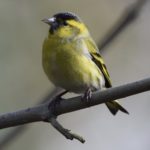The Siskin
The Siskin
Spinus spinus

This year my garden has been full of Siskins. They have taken over from the Greenfinches I used to have ten years ago, and now the Chaffinches, whose numbers are also in decline, mainly caused by a debilitating disease called papillomavirus or scaly leg. This horrible disease causes the finches’ legs to become deformed and they unable to feed properly. It is essential, if we choose to feed our garden birds, to ensure that all feeding equipment and drinking water is kept scrupulously clean with regular washing in diluted sterilising liquid and using brushes that are kept outside away from contamination. This routine doesn’t take long and will save our finches
The Siskins however are back in numbers, smaller than Chaffinches, these small, plump, pretty little finches have banded feathered plumage and with brown, green and yellow markings, a beautiful little forked tail and the characteristic finch seed eating bill. Their plumage is predominately a yellow-green colour on the wing, with yellow patches at the base of the tail. Adult males have a black crown and a lot of black on the wing that contrasts with the yellow wing band. Females are greener in colour than the males, streaked above and without the black crown. Juveniles resemble females, but are buff brown above and more heavily streaked, both above and below
They reside here all the year round, but numbers can increase in the Summer when further Siskins migrate here from the continent to take advantage of our more temperate climate. They feed on some insects and seeds from trees such as Conifer, Alder, and Birch, they are currently enjoying my sunflower seed feeder
Athene English
Photograph by Matthew Stadlen